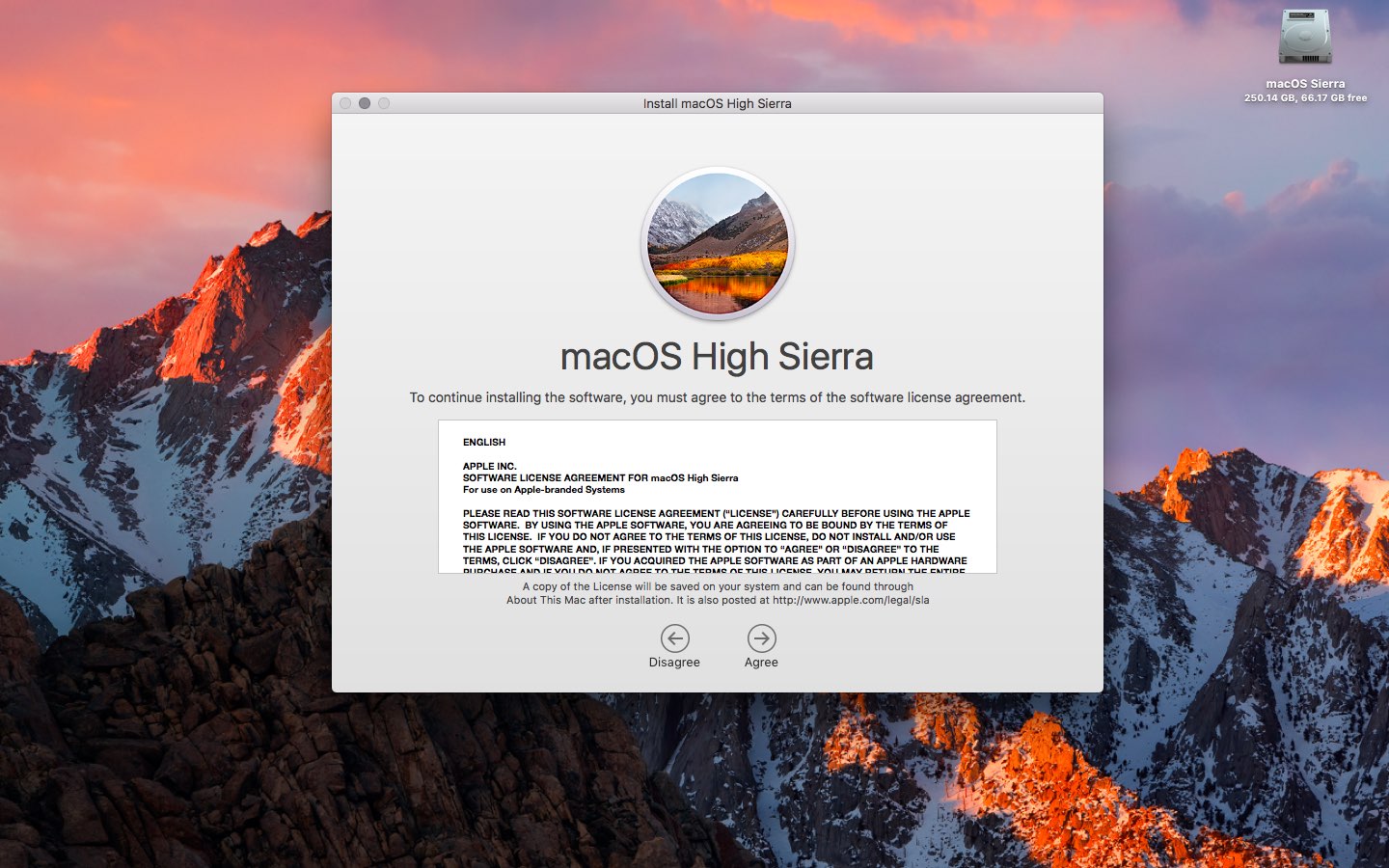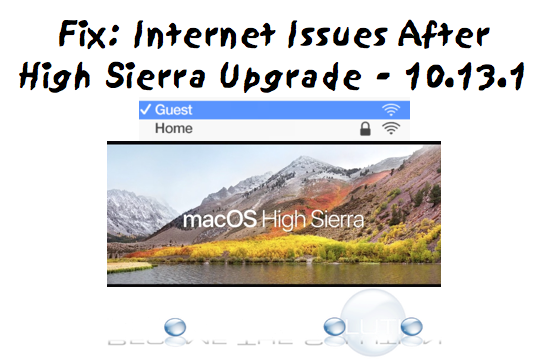The macOS High Sierra 10.13.6 Update adds AirPlay 2 multiroom audio support for iTunes and improves the stability and security of your Mac. This update is recommended for all users. If you haven't updated to Catalina yet, read on to find out how to update to Catalina or Mojave from High Sierra, Sierra, El Capitan, Yosemite, or even older version of Mac OS X below. Untangling Confusion: The original 'Security Update 2019-004 (High Sierra)' contained a bug that affected Sleep mode on a few recent Mac models. Without explanation, Apple pulled the update for several days. Then, without explanation, Apple made the update available again with modifications that removed the Sleep bug.
- Update Mac High Sierra To Mojave
- Update Mac High Sierra To Latest
- Mac High Sierra 10.13.6 Update
- Update Mac High Sierra To 10.14
Apple File System (APFS)
- APFS is a new, advanced storage architecture providing an extensible foundation to support new features and future storage technologies on the Mac.
- APFS brings support for the latest high-capacity storage devices and delivers enhanced performance, security and reliability.
- With APFS, common operations such as copying files and directories are nearly instantaneous.
- Data is protected from power outages and system crashes thanks to advanced data integrity features.
- APFS currently supports every Mac with all‑flash internal storage — support for Fusion and HDD Mac systems will be available in a future update.
Update Mac High Sierra To Mojave
- HEVC (H.265) is a new industry standard that enables extremely efficient compression, streaming and playback of video.
- HEVC enables users to watch 4K video files at full quality, while requiring 40 percent less storage space than the current H.264 standard.1
- With HEVC, Apple is enabling high-quality 4K video streaming on networks where only HD streaming was previously possible.2
- Hardware acceleration on the new iMac and MacBook Pro delivers incredibly fast and power-efficient HEVC encoding and playback.
- Developers like Adobe, Blackmagic Design, GoPro and more are joining Apple in adopting HEVC.
- Metal is Apple’s advanced graphics technology and the fastest, most efficient way to tap into GPU power on the Mac.
- Metal 2 supports next-generation experiences like machine learning used in speech recognition, natural language processing and computer vision.
- Metal 2 features a refined API and improved performance that’s helping developers, including Unity, Epic, Valve, Pixelmator and more, accelerate their future apps.
- With the combination of Thunderbolt 3 and Metal 2, the most demanding Mac users can now access powerful external GPUs.
Core ML
- With Core ML, Apple brings the power of machine learning to all Apple developers, enabling the creation of entirely new kinds of apps.
- Core ML takes full advantage of Metal and Accelerate, delivering incredible power, speed and efficiency to machine learning operations such as computer vision, natural language and support for convolutional and recurrent neural networks.
- All of the computation and processing driven through Core ML is done on-device in a way that respects customers’ data and privacy.
- Developers are already using Core ML to enhance apps like Pixelmator Pro, which uses machine learning to detect and understand various features within images and create intelligent editing solutions.
- macOS High Sierra adds support for VR content creation for the first time, enabling developers to create immersive gaming, 3D and VR content on the Mac.
- Leading VR companies are working with Apple to drive VR innovation on the Mac with features coming later this year.
- Valve is optimizing its SteamVR platform for macOS and enabling connection of the HTC Vive headset, while Unity and Epic are bringing their VR development tools to macOS.
- Later this year, Final Cut Pro X will add support for professional 360-degree VR workflows with the ability to import, edit and export 360-degree video on the Mac.
- An updated, always-on sidebar and new filtering and selection tools make photo organization quick and easy.
- A refreshed editing UI includes powerful new editing tools like Curves, for fine-tuning contrast, and Selective Color, for making adjustments to a specific color range.
- Live Photos can now be edited with fun effects, like Loop, Bounce and Long Exposure, and users can also choose a different key photo.
- Third-party editors like Photoshop, Pixelmator and other apps can be launched from Photos, with edits saved back to the Photos library.
- Support for third-party project extensions provides access to printing and publishing services from Shutterfly, WhiteWall, Wix, ifolor, Mimeo and Mpix from right within the app.
- Safari stops media with audio from automatically playing in the browser, and Reader can automatically open articles in a clean, uncluttered format.
- Intelligent Tracking Prevention in Safari detects and eliminates cookies and other data used by advertisers for cross-site tracking, to help keep a user’s browsing private.
- Siri on the Mac responds with a more natural voice and learns music preferences, creates custom playlists and answers music trivia when using Apple Music.
- Touch Bar on MacBook Pro gets new Control Strip options plus an improved color picker and more video controls.
- Notes adds simple tables, allowing a user to type in cells, make edits and move rows and columns.
- Spotlight provides flight status information, including departure and arrival times, delays, gates, terminals and even a map of the flight path.
Update Mac High Sierra To Latest
Images of macOS High Sierra
1 Amount of disk space saved depends on specific video file and hardware used. Actual results may vary.
2 The playback of 4K HEVC content requires a Mac with a sixth‑generation Intel Core processor or newer.
Press Contacts
Starlayne Meza
Apple
(408) 974-3391
Apple Media Helpline

(408) 974-2042

While the yearly major macOS update system is free to install, it is still limited to Macs that Apple deems compatible, and every year a generation of Macs essentially becomes obsolete. This is despite the fact that Apple is eager to emphasize that macOS is a widely compatible operating system.
As it happens, there are still people with close to ten-year-old Apple desktop computers still in use on a daily basis, likely performing a range of lighter tasks.
Download CleanMyMac X from MacPaw’s website and clean up to 500MB of junk data from your computer while enjoying all the features of the software without major limitations.
Which Macs Don't Support High Sierra
For some reason Apple doesn't want to allow these Macs to run one of its latest operating systems, namely macOS 10.13 High Sierra. This leaves the following Macs on macOS 10.11 El Capitan:

- MacBook Pro – late-2009 or earlier models
- MacBook – late-2008 or earlier models
- MacBook Air – 2009 or earlier models
- iMac – late-2008 or earlier models
- Mac Mini – 2009 or earlier models
- Mac Pro – 2009 or earlier models.
These machines are considered obsolete and vintage by Apple. The company defines vintage products as those that have not been manufactured for more than five years but less than seven years ago. Obsolete products are those discontinued more than seven years ago.
How To Install macOS High Sierra on Unsupported Macs
Though Apple doesn't support the above hardware officially, someone has thought about sharing the love for these older machines. A developer known as DOSDude1 has written a patch that works on Macs with the Penryn architecture. Using this still imposes certain limitations, but at least makes it possible to install macOS High Sierra on the following Macs:
- Early-2008 or newer Mac Pro, iMac, or MacBook Pro (MacPro 3,1 and 4,1, iMac 8,1 and 9,1, MacBook Pro 4,1, 5,1, 5,2, 5,3, 5,4, and 5,5).
- Late-2008 or newer MacBook Air or Aluminum Unibody MacBook (MacBook Air 2,1, MacBook 5,1).
- Early-2009 or newer Mac Mini or white MacBook (Mac Mini 3,1, MacBook 5,2)
- Early-2008 or newer Xserve (Xserve 2,1, Xserve 3,1).

If you happen to own any of the Penryn Macs mentioned above, the macOS High Sierra Patch Tool written by DOSDude1 will make running the latest software possible. But remember, with High Sierra you will also migrate to the Apple File System, and it is highly recommended that you first disable SIP because it may prevent the patch from working at all.
Installing the operating system on any of these Macs will require some technical knowledge, so it is not recommended for novice users. Also, a backup of your data is always a good idea in case anything goes wrong.
While there is a full step-by-step tutorial and video tutorial available on DOSDude1's website, it’s good to get a summary of the basics, which start with downloading the macOS High Sierra Installer app from the Mac App Store:
- Format a USB drive as Mac OS Extended (Journaled) via Disk Utility.
- Open the macOS High Sierra Patcher tool, navigate to the High Sierra Installer App, then select your pen drive and click “Start Operation”.
- Boot from the USB drive by holding down the option key after reboot.
- Install macOS normally, reboot back on the installer drive, and then open the “macOS Post Install” application.
- From the options, select the Mac model you own. This step is important, because it contains the optimal patch for that specific model.
- Click the “Patch” button, and after the process has finished, click “Reboot”.
The Reason Not To Install macOS High Sierra on an Unsupported Mac
As you may have already experienced with other types of officially unsupported machines, the probability of having issues is much higher. The same applies in this case, too, since the macOS High Sierra Patcher will render your iMac 8.1 Broadcom Wi-Fi chip useless for certain models.
Macs that use the Broadcom BCM4321 Wi-Fi module will not have functional Wi-Fi when running High Sierra. Another issue that has been highlighted by the developer is that the trackpad in the MacBook 5,2 isn't fully supported in this version of OS.
These are just a few of the possible issues that could arise, and this is before even mentioning the various potential software errors that you can run into by using out-of-date hardware. Without getting the proper knowledge beforehand, you'll need to revert back to the previous state of the Mac, which won't be an easy process, especially not without a Time Machine backup.
Best Mac Optimization Software of 2021
| Rank | Company | Info | Visit |
| |||
| |||
|
Mac High Sierra 10.13.6 Update
Get the Best Deals on Mac Optimization Software
Update Mac High Sierra To 10.14
Stay up to date on the latest tech news and discounts on Mac optimization software with our monthly newsletter.
